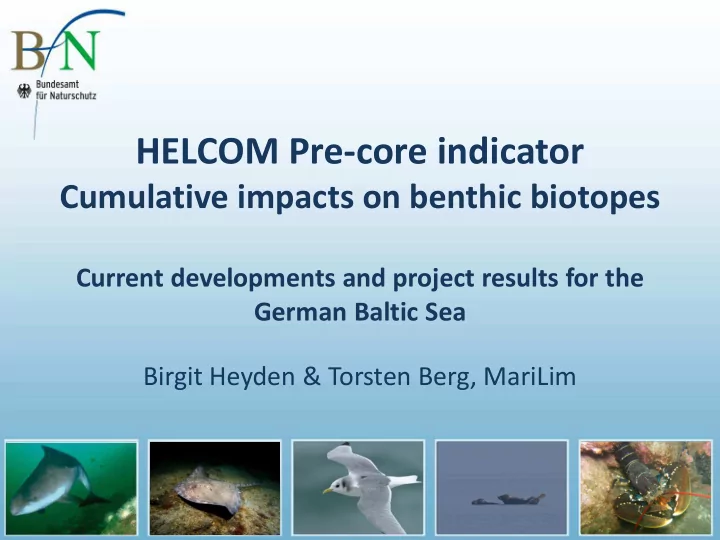

HELCOM Pre-core indicator Cumulative impacts on benthic biotopes Current developments and project results for the German Baltic Sea Birgit Heyden & Torsten Berg, MariLim
Status • Indicator D6C3 MSFD, information on D6C1 and D6C2 as additional benefit • Indicator of high priority lead together by Germany and Sweden (S&C 6-2017, recalled by S&C 7-2017) • ‘Cumulative impact on benthic biotopes’ indicator (CumI) as long-term target , BSII as interim solution for HOLAS II purposes (TAPAS benthic indicator WS 1-2016) • Presentation of current developments S&C 7-2017, FISH 7- 2017 and IN-BENTHIC 2-2018
Basics • Indicator assessment evaluates multiple physical pressures on the seafloor and its biotopes: fishing, dredging, dumping, marine constructions • Impacts are cumulative when there is spatial and temporal overlap • Categorical approach based on matrix operations, partly comparable with OSPAR BH3 indicator
Method/assessment procedure Resistance Frequency Impact Pressure Sensitivity Intensity Resilience Individual impacts derived from • specific pressures combined with sensitivities Final cumulative impact on • benthic biotopes derived by intersecting individual impacts in sequence
Method/assessment procedure Biotope map as a basis (including abiotic and biotic components), • broad scale habitats with HUB level 4 as minimum requirement Classification of pressure magnitudes and pressure specific • sensitivities for the different biotopes used (matrix 1 and 2) Frequency 1 Magnitude of persistent frequent regular occasional pressure intersection (more than three times (two to three times (once per year) (less than once per matrix per year or permanent) per year) year) high High High Moderate Moderate (0.75–1) moderate Intensity High Moderate Moderate Low (0.5–0.75) low Moderate Moderate Low Very low (0.25–0.5) very low Moderate Low Very low Very low (0–0.25) resilience 2 Sensitivity very low low moderate high intersection matrix (> 10 years) (5–10 years) (1–5 years) (<1 year) very low High High Moderate Moderate resistance low High Moderate Moderate Low moderate Moderate Moderate Low Very low high Moderate Low Low Very low
Method/assessment procedure Transformation of pressures to impacts (matrix 3) by intersection of • magnitude of pressure and sensitivity 3
Method/assessment procedure Cumulation process by pairwise intersection (matrix 4) of individual • impacts 4
Sensitivities + pressures = impact Pressure specific sensitivities: Abrasion/penetration divided into surface (≤ 2.5 cm) and subsurface (> 2.5 cm) • Based on compilation by ICES WKFBI to resistance, resilience and sensitivity •
German test case results 2017 Main impacts from fisheries, secondary impacts from dredging, • dumping, extraction and constructions In most cases areas of ‘very low’ and ‘low’ impacts correspond to • NATURA 2000 sites
Ongoing adjustments Increase of impact classes from 4 to 7 (5 of them for significant • impacts divided in 3 moderate and 2 high classes) according to the required separation of loss and disturbance very high loss high high disturbance m3 disturbance moderate m2 disturbance m1 disturbance Boundary of significant impacts low low disturbance very low very low disturbance Testing of different buffering procedures and influence on assessment • results
Adjusted matrices Matrix 3: differentiation of resulting impact classes to refine assessment of disturbance and separate it from loss Magnitude of pressure Impact intersection 3 matrix High Moderate Low Very low High High/vh High/h Moderate/m2 Moderate/m1 Sensitivity Moderate High/h Moderate/m3 Moderate/m1 Low Low Moderate/m2 Moderate/m1 Low Very low Very low Moderate/m1 Low Very low Very low Matrix 4: adapted cumulation process Impact 2 4 Cumulation matrix expanded high Moderate/m3 Moderate/m2 Moderate/m1 Low Very low high Very high Very high high high high high Moderate/m3 Very high Very high high m3 m3 m3 Impact 1 Moderate/m2 high high m3 m2 m2 m2 Moderate/m1 high m3 m2 m2 m1 m1 Low high m3 m2 m1 Low Low Very low high m3 m2 m1 Low Very low
Physical loss Initial map for loss • All cumulative disturbance resulting in loss is subsequently • transferred to loss map (and removed from disturbance map)
Quantitative assessment Boundary between ‘low’ and ‘moderate’ cumulative impacts defined as • ‘significant impact’ or adversely affected in the sense of D6C3 Spatial extent of significantly impacted area less than 25 % of overall • biotope area as basic proposal for good environmental status in combination with 10 % not impacted area (comparable to OSPAR BH 3 assessment, national proposal of Germany used in MSFD reporting for the North Sea) Development of numerical values or ratios in preparation • Further modifications needed for rare and threatened biotopes (HD, • Red listed biotopes), currently not covered within the proposal
Outlook Assessment of cumulative impacts on different levels of detailed data • (broad scale habitats or biotopes HUB level 5/6) with corresponding broad or pressure specific sensitivities and variable number of pressures to determine factors relevant for the resulting impact, improvements in spatial assessment scales (e.g. fishery) Further modifications of pressure and sensitivity classification in order to • improve the confidence in the resulting magnitude of pressure and the assessment depending on data availability Automation of assessment via GIS models/workflows (buffering, • intersection process) for easier application of CumI and reduced manual workload
Thank you!
Recommend
More recommend